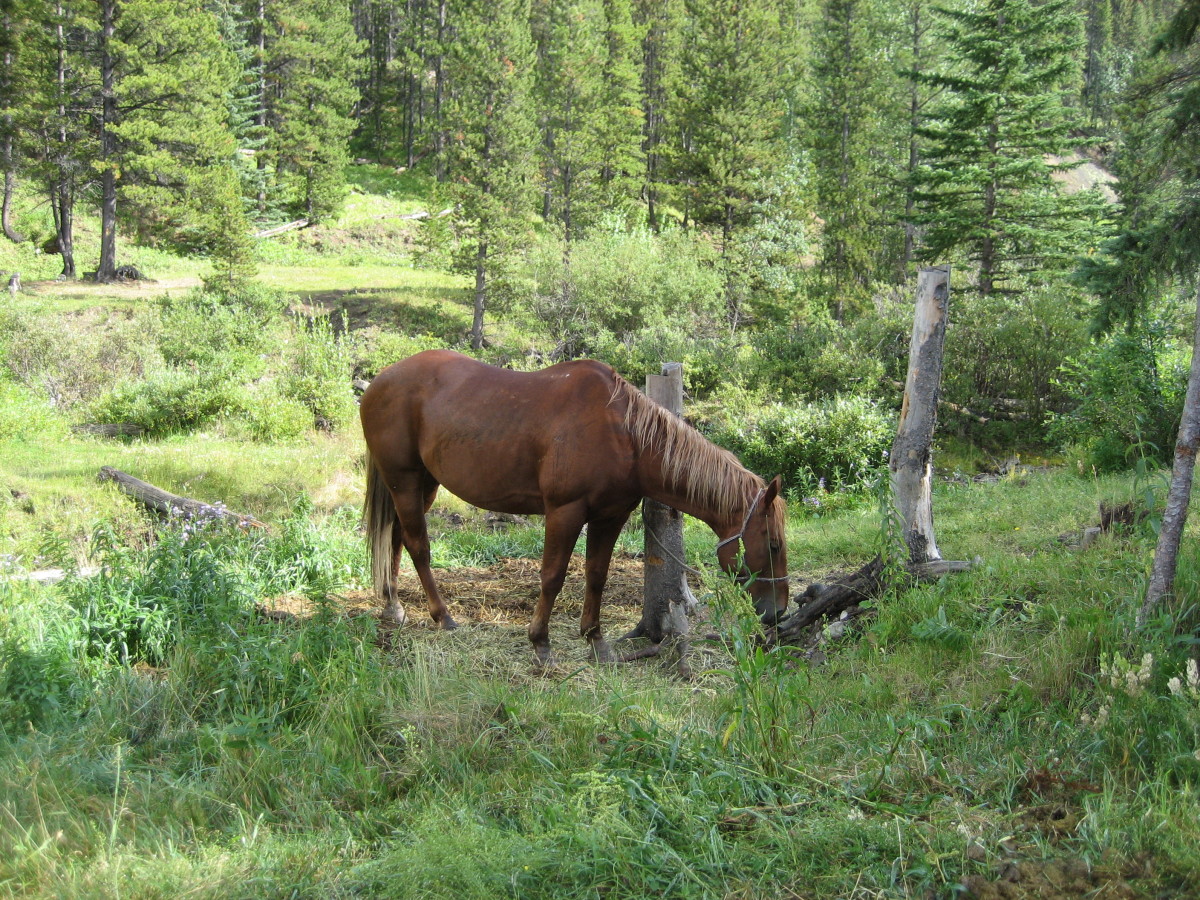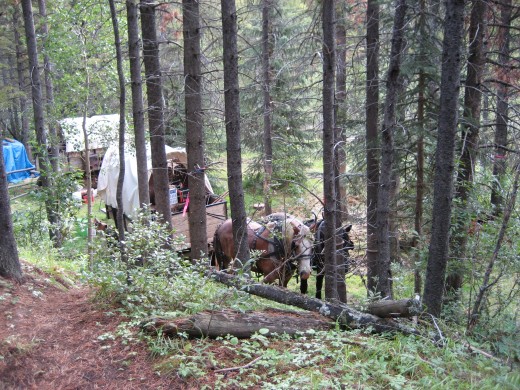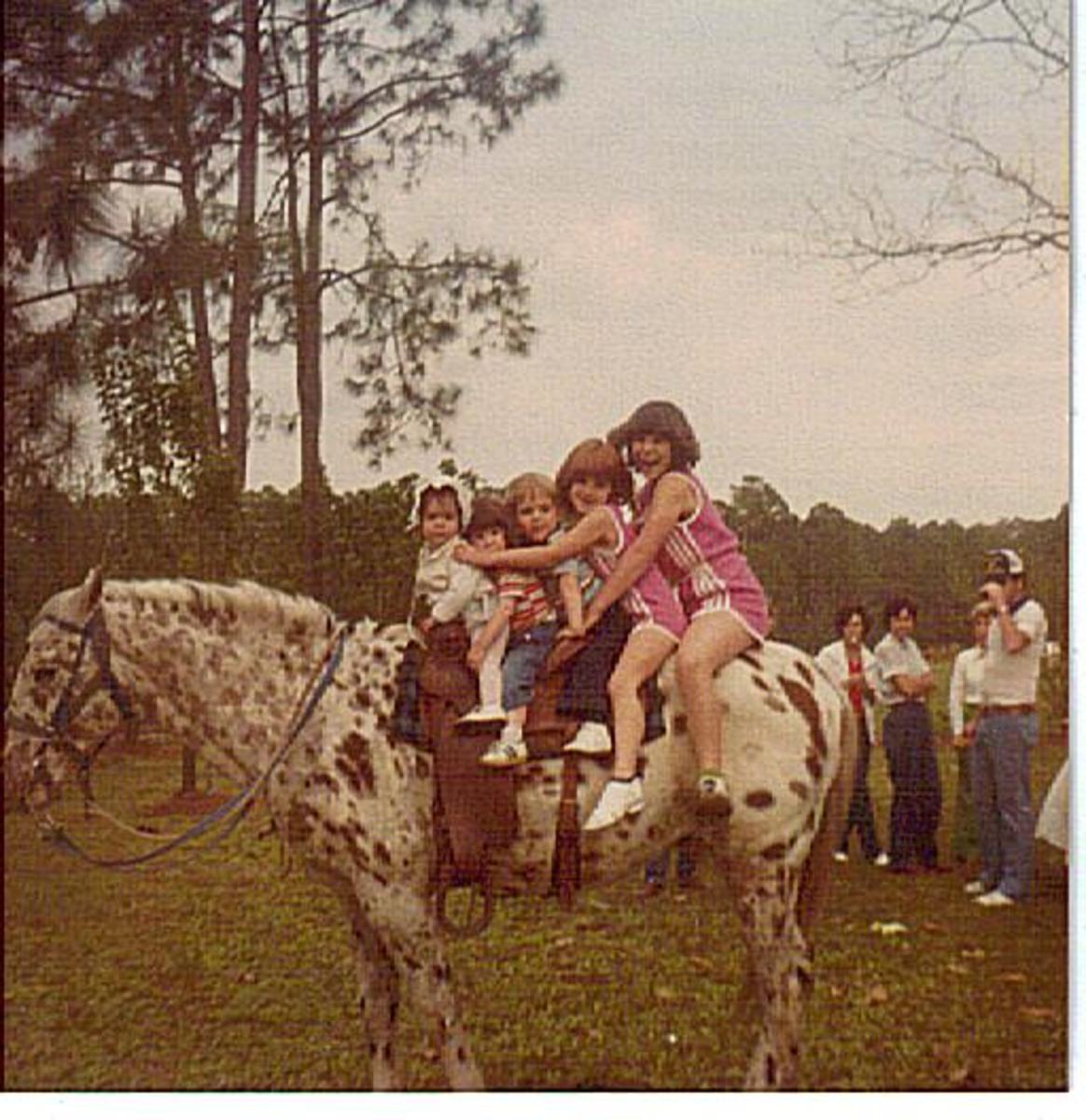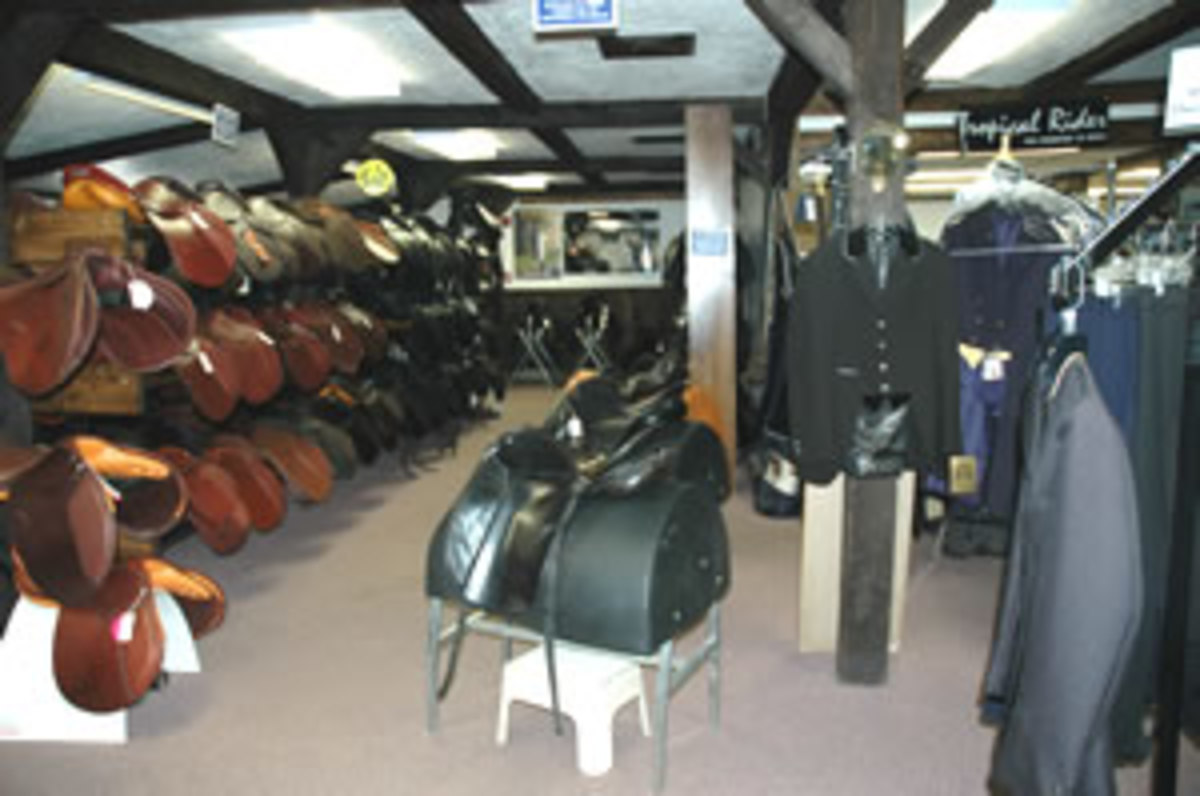No Hoof, No Horse - The Importance of a Horse's Feet

What Is a Horse's Hoof?
Horses have a single hoof (unlike cattle, that have 'cloven' hooves). This means that they are actually standing on one toe.
The hoof itself is made of keratin - the same stuff as our fingernails. Keratin is a 'dead' material, and a horse's ability to feel through its feet depends on pressure of the hoof on the soft tissue underneath or pressure on the frog of the foot.
If you lift a horse's foot, you will see that the hoof forms a ring around the sole, and also a triangle that protrudes from the sole, the point forward and the back leading to the horse's 'heel' (which is actually what's left of what would have been a pad when horses had paws). This triangular structure is the frog, and it comes into contact with the ground when the horse travels. The frog is extremely vital to a horse and should never be trimmed or altered. Without it, they can't properly tell where they are putting their feet.
Basic Hoof Care
As a bare minimum, a horse's hooves and feet should be inspected daily. A hoof pick is used to clean the dirt and mud that tends to collect against the sole, between the frog and the hoof.
Most people will also clean their horse's hooves inside and out using a stiff bristled brush. Some horses have extensive hair falling over their feet, called feather, which also needs to be brushed.
If the horse flinches when the hoof pick or brush comes into contact with the hoof, then there is a problem, most likely a bruise or an abscess, that needs to be addressed.
Horse Shoes
The majority of working horses are shod. Shoeing slows hoof wear and many believe a shod horse is more comfortable.
Traditional horse shoes are made of iron or steel and are nailed onto the hoof. As the hoof is dead material, the horse does not feel pain when shod (unless, of course, the person doing it screws up, which is rare, but not unknown). In hot shoeing the horse is either taken to the forge or, more likely, the farrier brings a mobile forge that runs off of a van engine, and the shoes are heated, shaped, and then immediately applied. Cold shoeing means applying a shoe of standard size that was made earlier. Cold shoeing is cheaper, but some people believe hot shoeing results in a better fit and, ultimately, a more comfortable horse.
Racehorses are often shod differently. Most racehorses are shod using shoes that look the same as normal riding shoes (although they are specially designed to give the horse better traction when running flat out, but are made of aluminum rather than steel. Aluminum shoes wear faster, but are much lighter, and in racing, every bit of weight that can be saved matters. Yearlings and racehorses in training, and some trotters, are shod with steel so that when they are switched to the aluminum shoes their hooves feel 'lighter'. Some racehorses are shod with extremely light composite shoes that are glued to the hoof rather than being nailed on.
Shoeing and Trimming
Horses that wear shoes generally need a visit from the farrier to reset or replace (depending on wear) their shoes every six to eight weeks. Horses that do not wear shoes also need attention in the same time frame. As domestic horses do not cover the same distances looking for food as wild horses, their hooves tend to grow faster than they wear, resulting in balance issues and, eventually, permanent damage to their hooves and feet.
A farrier both trims hooves and shoes horses. A trimmer or barefoot trimmer only trims hooves and may charge less. It is also possible to learn to trim hooves yourself, although this takes a lot of time and is only worth it if you have several horses. A good farrier or trimmer will also do a thorough inspection of your horse's feet and may well spot a problem before the horse actually becomes lame.
It is never normal for a horse to be lame or sore immediately after its hooves are done, whether shod or barefoot.
The Barefoot Issue
There is a strong movement, especially in the United States, to completely eschew the use of shoes. Some people consider that shoeing a horse reduces the shock absorbency of the feet, making lameness higher up in the leg more likely. They also argue that it has a negative effect on hoof quality.
Many horses are quite capable of working barefoot. I have seen ponies and cobs do several hours a day, including trotting on concrete, with either no shoes or just shoes in front, and suffer no hoof problems as a result. Others really do need shoes. Thoroughbreds, for example, are more likely to need shoes as their soles tend to be lower to the ground because of their hoof conformation, selected for speed - although I have seen Thoroughbreds that are quite happy barefoot.
The decision of whether or not to shoe should be made by considering the horse's conformation, hoof quality and work load. For those uncomfortable with the idea of nailing shoes to their horse's hooves, there are alternatives. Glue on shoes are one possibility. If you prefer no shoes, then it is often worth investing in a set of hoof boots. Hoof boots slide on and secure over the hoof to provide temporary protection, for example if trail riding on rocky ground. They're basically the same thing as the shoes we wear ourselves.
My personal philosophy is that horses should be barefoot if possible, shod if necessary.
Corrective Shoeing and Trimming
Just as people sometimes need to wear a certain kind of shoe to correct a foot problem, so some horses need corrective shoes or a special trim.
Navicular, a condition common in stock horses that is characterized by inflammation of the tissue between one of the small bones in the foot, the navicular bone, and the flexor tendon that allows a horse to bring its hoof backwards, is often treated with corrective shoeing. A normal horseshoe is open at the back to allow the frog to touch the ground. Shoes for horses with navicular are called 'egg bar' shoes, because they resemble an egg, surrounding the horse's hoof completely. These are generally used in conjunction with a rubber pad to support the frog. Another approach is barefoot with a special trim to change the angle of the horse's foot. I have seen both methods work to provide relief, and believe that it may well depend on the individual horse.
Corrective shoeing or trimming is also sometimes used on foals and young horses. For example, a farrier may trim one side of the hoof shorter than another to help straighten a crooked leg.
Horses that have foundered, which I will discuss in a moment, may also benefit from special shoes.
Founder
The term 'founder' is a nautical one that refers to sinking. When a horse founders, the bone in the hoof rotates downwards. In severe cases, the bone may come through the sole of the foot - horses that suffer from this problem generally have to be euthanized.
Founder has two main causes. The less common, these days, is 'road founder'. Road founder is most often seen in carriage horses that work on the road all the time, hence the name. It used to be a common problem when horses were the primary means of transportation. Sometimes, it is seen in competition and race horses asked to compete on very hard ground. It is caused by pure mechanical trauma.
The more common cause of founder is laminitis. Laminitis is an inflammation of the tissue that supports the hoof, and can cause founder and hoof loss (which also generally ends with euthanasia). Laminitis is, quite simply, a disease of obesity. It is most commonly seen in ponies and Draft horses that tend to be easy keepers, and is prevented by keeping their weight down. Some ponies may have to be kept on extremely harsh diets - most of the pony breeds were developed to endure and thrive on poor fodder and when they are put on good grazing they turn into little balloons on hooves very quickly. A horse that has had laminitis will have to be kept on a strict diet for the rest of its life.
Regardless of the cause, founder requires hoof care for treatment. A heartbar shoe that provides full support for the frog is often used. Special trimming, with or without shoes, is the best treatment, however. The farrier or trimmer will aim to adjust the support in order to take pressure off the sensitive structures within the hoof and encourage the bone concerned (called the coffin bone) to return to its normal position.
A horse that has foundered once is extremely likely to do so again. They need to have their weight kept down (even if it was mechanical founder) and their feet very carefully monitored. In some cases, it may be necessary to restrict the amount of weight they are allowed to carry to ten percent of their body weight rather than the normal fifteen to twenty percent.

Shoes For Courses
Most ordinary riding horses wear ordinary shoes. Racehorses and competition horses, however, often have something a little more special.
As previously mentioned, racing shoes (called plates) are often made of aluminum. They are also carefully designed to increase grip and traction for a horse running all out. Trotters wear different shoes from Quarter Horses and Thoroughbreds. Their hooves are also trimmed in a way that has been proven to increase traction and, thus, speed. High end racehorses often receive custom shoes, made to give that particular horse the best chance of winning it has.
For other horses, special shoeing often revolves around studs. Carriage horses and in some parts of the world most riding horses (in England, for example, it is often impossible to avoid riding on the road) are shod with road studs. Road studs are often, but not always, permanently attached to the shoe. They are small, blunt and located on the inside. Road studs are designed to keep a horse from slipping on smooth tarmac.
Competition studs are generally more like bolts. The shoes are designed with screw holes in them and the studs are attached as needed, then removed before turning the horse out or to replace them with a different stud. Because competition studs are taller than road studs, they are kept in only when riding the horse. Most competitors have several sets of studs (they're cheap) designed to use on different goings. For example, one might use pointed studs designed to penetrate the ground on hard going and rounded ones to give traction in mud.
Even some trail horses may have special shoes. For example, the mules that are ridden into the Grand Canyon have very special shoes, designed both to fit the slightly different foot shape of a mule and give them the absolute maximum grip in rough terrain. Mountain horses often have special shoes or studs to help them negotiate narrow, unkempt trails.
Horses that are not shod may have special boots put on their feet to serve the same purpose.
Preserving Hoof Health
There are three common problems with horse's hooves.
1. Bruises. Bruising happens when a foreign object, usually a stone, gets caught between the frog and the hoof wall. The object bangs against the sole and causes minor damage. A horse with a foreign object may abruptly go lame, and then be perfectly sound again if the object is removed. The first action with any sudden lameness in the middle of a ride should be to check the hooves for stones. On trail rides, carry a folding hoofpick (not the regular kind, in case you fall on it).
2. Hoof abscesses. A hoof abscess is a bacterial infection, usually found in the sole, but occasionally behind the hoof wall. Abscesses result in sudden and severe pain and can sometimes cause heat in the hoof or further up in the leg. They are one of the most common causes of lameness and should be one of the first thing you check for. Abscesses are most often caused by moisture and are more common in stalled horses. They can also be caused by sole penetration either by a foreign object or by a farrier missing and driving a nail into the 'quick'. A few abscesses are symptomatic of poor blood flow to the top of the hoof. An abscess is treated by removing any shoes, thoroughly cleaning the feet and then locating and draining the abscess by cutting through the hoof with a hoof knife. Very high abscesses tend to migrate up to the coronary band and in that case, cutting is not done. The hoof is then poulticed and wrapped until the abscess is cleaned. Epsom salts are normally used. Most horses recover from an abscess in a few days if properly treated.
3. Poor hoof quality. Some horses simply don't grow very good hooves. Signs of this include chipping or even cracking at the base of the hoof. These cracks may or may not be painful to the horse, depending on how deep they are. Shoeing a horse generally does not reduce hoof quality (although some horses do develop short term hoof problems if they are moving from shod to barefoot, these problems go away as soon as new hoof is properly formed, usually within a week or two). Hoof quality may be genetic, and I personally would recommend against breeding any horse with a history of poor hoof quality. The only real treatment is to give the horse an oral supplement containing biotin. Biotin is an essential nutrient for keratin production. There are also hoof ointments that can help prevent cracks from spreading further up the hoof, which have to be applied daily.




